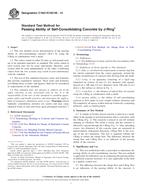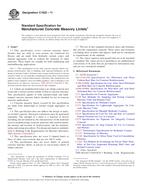Wir benötigen Ihre Einwilligung zur Verwendung der einzelnen Daten, damit Sie unter anderem Informationen zu Ihren Interessen einsehen können. Klicken Sie auf "OK", um Ihre Zustimmung zu erteilen.
ASTM D7276-08
Standard Guide for Analysis and Interpretation of Test Data for Articulating Concrete Block (ACB) Revetment Systems in Open Channel Flow
Automatische name übersetzung:
Standard-Leitfaden für Analyse und Interpretation der Testdaten für Gelenkbetonblock (ACB) Verkleidung Systeme in offenen GerinneNORM herausgegeben am 1.8.2008
Informationen über die Norm:
Bezeichnung normen: ASTM D7276-08
Anmerkung: UNGÜLTIG
Ausgabedatum normen: 1.8.2008
SKU: NS-38062
Zahl der Seiten: 9
Gewicht ca.: 27 g (0.06 Pfund)
Land: Amerikanische technische Norm
Kategorie: Technische Normen ASTM
Kategorie - ähnliche Normen:
Die Annotation des Normtextes ASTM D7276-08 :
Keywords:
articulating concrete blocks, channel stability, erosion, erosion control, open channel flow, overtopping, revetment, ICS Number Code 91.100.30 (Concrete and concrete products)
Ergänzende Informationen
| Significance and Use | ||||||||||
|
This standard is intended for use by researchers and designers to assess the stability of articulating concrete block (ACB) revetment systems in order to achieve stable hydraulic performance under the erosive force of flowing water. An articulating concrete block system is comprised of a matrix of individual concrete blocks placed together to form an erosion-resistant revetment with specific hydraulic performance characteristics. The system includes a filter layer compatible with the subsoil which allows infiltration and exfiltration to occur while providing particle retention. The filter layer may be comprised of a geotextile, properly graded granular media, or both. The blocks within the matrix shall be dense and durable, and the matrix shall be flexible and porous. Articulating concrete block systems are used to provide erosion protection to underlying soil materials from the forces of flowing water. The term “articulating,” as used in this standard, implies the ability of individual blocks of the system to conform to changes in the subgrade while remaining interconnected by virtue of block interlock or additional system components such as cables, ropes, geotextiles, geogrids, or other connecting devices, or combinations thereof. The definition of articulating concrete block systems does not distinguish between interlocking and non-interlocking block geometries, between cable-tied and non-cable-tied systems, between vegetated and non-vegetated systems or between methods of manufacturing or placement. This standard does not specify size restrictions for individual block units. Block systems are available in either open-cell or closed-cell varieties. |
||||||||||
| 1. Scope | ||||||||||
|
1.1 The purpose of this guide is to provide recommended guidelines for the analysis and interpretation of hydraulic test data for articulating concrete block (ACB) revetment systems under steep slope, high velocity flow conditions in a rectangular open channel. Data from tests performed under controlled laboratory conditions are used to quantify stability performance of ACB systems under hydraulic loading. This guide is intended to be used in conjunction with Test Method D 7277. 1.2 This guide offers an organized collection of information or a series of options and does not recommend a specific course of action. This document cannot replace education or experience and should be used in conjunction with professional judgment. Not all aspects of this guide may be applicable in all circumstances. This ASTM standard is not intended to represent or replace the standard of care by which adequacy of a given professional service must be judged, nor can this document be applied without considerations of a project’s many unique aspects. The word “Standard” in the title of this document means only that the document has been approved through the ASTM consensus process. 1.3 The values stated in inch-pound units are to be regarded as standard. The values given in parentheses are mathematical conversions to SI units that are provided for information only and are not considered standard. 1.4 This standard does not purport to address all of the safety concerns, if any, associated with its use. It is the responsibility of the user of this standard to establish appropriate safety and health practices and determine the applicability of regulatory limitations prior to use. |
||||||||||
| 2. Referenced Documents | ||||||||||
|
Ähnliche Normen:
Historisch
1.4.2014
Historisch
15.12.2011
Historisch
1.6.2011
Historisch
15.12.2008
Historisch
1.9.2011
Historisch
1.10.2009
Empfehlungen:
EEviZak – alle Gesetze einschließlich ihrer Evidenz in einer Stelle
Bereitstellung von aktuellen Informationen über legislative Vorschriften in der Sammlung der Gesetze bis zum Jahr 1945.
Aktualisierung 2x pro Monat!
Brauchen Sie mehr Informationen? Sehen Sie sich diese Seite an.



 ASTM C1621/C1621M-14..
ASTM C1621/C1621M-14.. ASTM C1623-11
ASTM C1623-11 ASTM C1634-11
ASTM C1634-11 ASTM C1646/C1646M-08..
ASTM C1646/C1646M-08.. ASTM C1677-11a
ASTM C1677-11a ASTM C1686-09
ASTM C1686-09
 Cookies
Cookies
